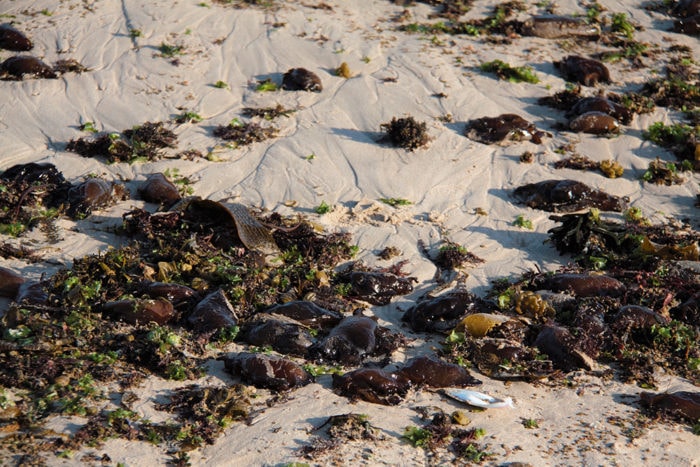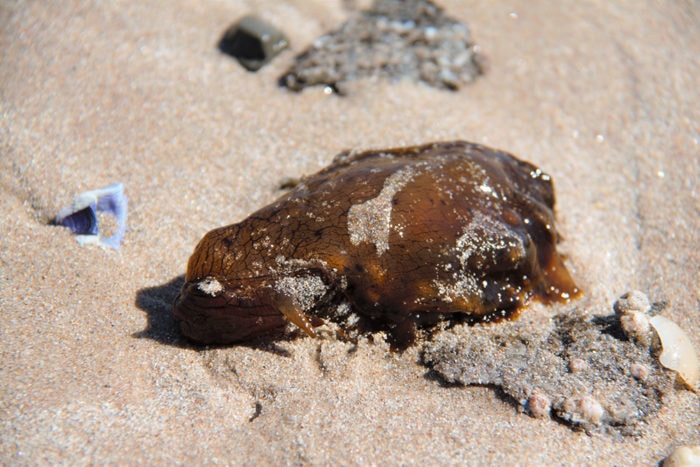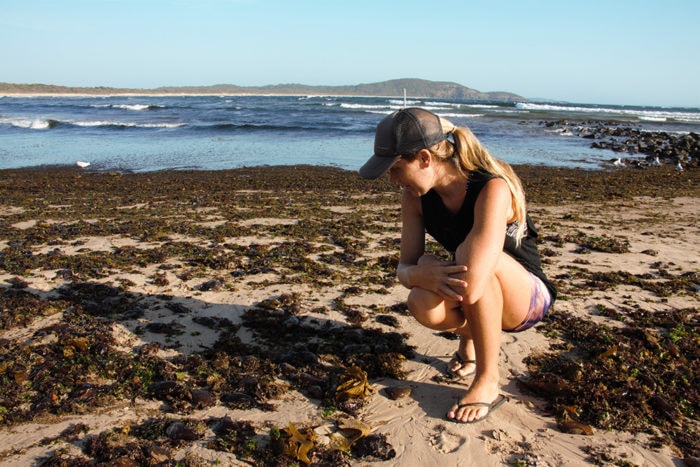Toxic slime, camouflage and purple dye: sea hares explained

THEY’RE UGLY and peculiar but sea hares (Aplysia dactylomela) are more common than you may realise. Hundreds of the brown, slug-like creatures washed up on Barries Bay Beach, north of Port Macquarie, New South Wales, recently, and just before that, some were spotted ashore at Lakes Entrance, Victoria.
To the uninformed eye, the gastropods look like blobs of jelly, lacking any distinguishable shell or limbs. But they’re fascinating creatures that have next to no predators thanks to a toxic slime and incredible camouflage capabilities.

Sea hares washed up on Barrie’s Bay, NSW. (Image credit: Jennifer Ennion)
What are they?
Professor Culum Brown, from Macquarie University’s Department of Biological Sciences, says sea hares are incredibly common, making regular visits to Australia’s coastline. There are several genera and hundreds of species, some of which can grow up to 14 kg. The standard size, however, is around 20 centimetres.
“They’re crazy common,” Prof. Brown says, although many people don’t know what they are. They live in seagrass beds, rock pools and other intertidal environments where there is a decent amount of algae.
“Because they graze on the algae, they take up the pigments and sometimes the toxins that’s found in the algae, and so their colour is really variable,” Prof. Brown says. “That’s obviously an awesome technique to [be able to] blend into your surroundings.”
Put simply, sea hares are like garden snails but instead of an obvious shell, they have an internalised shell similar to cuttlefish.
“Sometimes when they’re really scared, they retract their mantel completely and you can see the white shell,” Prof. Brown says.
Named for their large tentacles thought to resemble the ears of hares, these interesting creatures also have wing-like features used for swimming, although these may be hard to identify when they’ve rolled through the sand.
With a similar life cycle to squid and cuttlefish, sea hares grow and mature rapidly, usually within a year or two. As hermaphrodites, you’ll often find them breeding in chain formations, after which they lay spaghetti-like eggs (generally in late summer), and then die.

Details of the sea hares body, washed up on Barrie’s Bay. (Image credit: Jennifer Ennion)
Are they dangerous?
As a curious child, Prof. Brown played with sea hares on east coast beaches. It’s fine for people to pick them up and return them to the sea, but he says they should avoid rubbing their eyes or touching their mouth afterwards, and should also wash their hands, even if only in sea water.
The reason for this is the toxic dye and slime some sea hares secrete as a result of ingesting toxic algae. The dye is usually purple and released when the gastropods feel threatened.
According to the Australian Museum, the dye “works as a smoke screen, enabling them to escape from predators”. Sea hares can also have a semi-toxic slime layer over their bodies and toxins infused through their tissues. The slime is a defence mechanism and, combined with their great camouflage capabilities, means they have almost no predators.
Their toxicity is highly variable and depends on what the individual hare eats. In China, Hawaii and elsewhere, people eat sea hares, however in mid-2018, news sites reported the deaths of three dogs in separate incidents on West Australian beaches. It’s believed all pets came into contact with sea hares.
“The trouble with dogs,” Prof. Brown says, “is they go up and lick them and sometimes they eat them, too, and as soon as they go in your mouth, if they’re super toxic, then they can cause spasms…” and other reactions.
His advice to beachgoers is to stop dogs and small children from touching the creatures. However, he doesn’t want people to panic, as “for the most part, they’re pretty harmless.
“Even on the same beach you might find a whole bunch of them washed up and some of them will be completely fine and others will be totally toxic.”

Australian Geographic journalist Jennifer Ennion observing the washed up sea hares on Barrie’s Bay.
Why the mass mortality event?
When the hundreds of sea hares washed ashore Barries Bay Beach, in Limeburners Creek National Park, a popular camping area, they were among a thick bed of kelp and algae. It was only as beachgoers moved closer that the slimy, sometimes still squirming blobs were noticeable.
In the days prior, hares had washed up with the overnight tide, along with blue bottles and blue sea slugs (Glaucus atlanticus) – both of which have nasty stings. All of this coincided with a large volume of brown algae in the water off the national park and the nearby tourist village of Crescent Head.
Prof. Brown says witnessing large numbers of sea hares ashore, however, is fairly typical and we needn’t be concerned. He puts the stranding down to the weather conditions, which included days of strong north-easterly winds and rough surf conditions.
“Because they live in shallow water, they’re really prone to wind and wave action, particularly if it’s unusual and prolonged,” he says.




